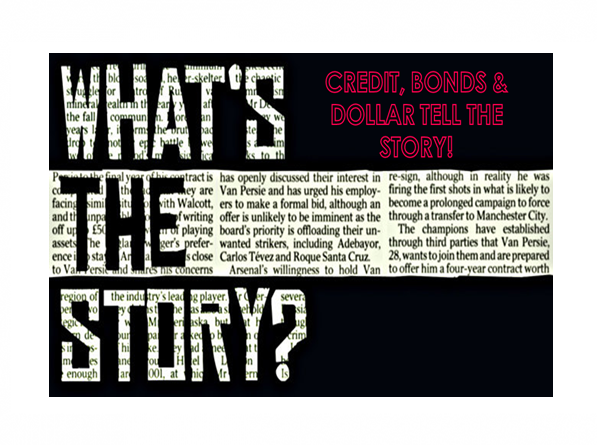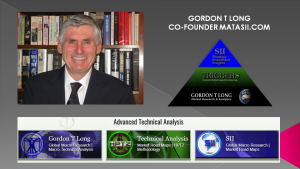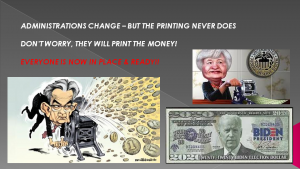IN-DEPTH: TRANSCRIPTION - UnderTheLens – 05-25-22 - JUNE – Credit, Dollar & Bonds Tell The Story
SLIDE DECK
TRANSCRIPTION
SLIDE 2
Thank you for joining me. I'm Gord Long.
A REMINDER BEFORE WE BEGIN: DO NO NOT TRADE FROM ANY OF THESE SLIDES - they are COMMENTARY for educational and discussions purposes ONLY.
Always consult a professional financial advisor before making any investment decisions.
COVER
It is pretty clear what the story is in the equity markets today by simply looking at the distinct messages coming out of the other financial markets.
The Credit, Dollar and Bond markets together tell us the story.
SLIDE 4
We will look at these markets in this session but in the context of being a mid-year update to our year beginning UnderTheLens video on our Macro Themes for 2022.
SLIDE 5
I show here the year beginning agenda with the six Macro Themes we discussed at that time.
SLIDE 6
We also discussed in our LONGWave video, “Investment Themes for 2022” highlighted here in red.
As you can see our discussion today on the Credit, Dollar and Bond markets addresses the areas highlighted in both the Investment Theme areas and two of the Macro Themes. These are also highlighted by the red box.
SLIDE 7
However, I think you will see as we go through the slides we have prepared, you will see that there are major overlaps and ramifications to the other Macro and Investment Themes highlighted in the lower red box. You will see this as we go.
SLIDE 8
As such we will cover the areas shown here for your reference and roadmap.
SLIDE 9
I have used this analogy of a “Dog” before and feel it is particularly important to revisit it at this time before wading into each of the market messages.
SLIDE 10
Many animals detect food and enemies with their nose and prior to seeing them or hearing them.
It has been my experience that financial markets are similar. The credit market is like a dog’s nose. It smells things before its other senses are aware.
The Bonds market is like the dog’s ears and the Currency markets are like the dog’s eyes. They quickly focus in on what the dog’s sense first sensed.
Equity markets are like the tail on the dog – wagging back and forth. The tail when alerted by the senses then either keeps wagging or suddenly stops! The “emotional” tail is the last reaction in what I will call the “Awareness Function”.
SLIDE 11
The “Awareness Function” has changed noticeably since the US came off the gold standard in 1971 and made the US Dollar a Fiat Currency, pegged to nothing other other than the credit and faith of the US government.
A Fiat Currency removes the pillars that Sound Money rests on.
In a fiat money system, credit expansion and business activity are inseparable.
It is impossible to grasp the meaning of the idea of sound money if one does not realize that it was devised as an instrument for the protection of civil liberties against despotic inroads on the part of governments.
Ideologically it belongs in the same class with political constitutions and Bills of Right.
So wrote Ludwig von Mises in The Theory of Money and Credit in 1912.
He further said:
The sound-money principle has two aspects. It is affirmative in approving the market's choice of a commonly used medium of exchange. It is negative in obstructing the government's propensity to meddle with the currency system.
Against this backdrop, modern day monetary systems appear to have been drifting farther and farther away from the sound money principle in the last decades. In all countries of the so-called free world, money represents nowadays a government controlled irredeemable paper, or "fiat," money standard. The widely held view is that this money system would be compatible with the ideal of a free society and conducive to sustainable output and employment growth.
SLIDE 12
Stock market performance as a consequence has become inseparable from fiat money expansion.
Milton Friedman stated:
The world is now engaged in a great experiment to see whether it can fashion a different anchor, one that depends on government restraint rather than on the costs of acquiring a physical commodity.
Irving Fisher, evaluating past experience, wrote:
"Irredeemable paper money has almost invariably proved a curse to the country employing it."
The primary cause for concern rests on a key characteristic of government controlled paper money: the system's unrestrained ability to expand money and credit supply. In contrast, under the (freely chosen) gold standard, money (e.g., gold) supply was expected to increase as well over time, but only in proportion to how the economy expanded—i.e., an increase in money demand, brought about by an increase in economic activity, would bring additional gold supply to the market (by, for instance, increased mining which would become increasingly profitable). As such, the gold standard puts an "automatic break" on money expansion—the latter would be, at least in theory, related to the economy's growth trend.
SLIDE 13
The government controlled fiat money system has no inherent limit to money and credit expansion. In fact, quite the opposite holds true: Central banks, the monopolistic suppliers of governments' money, have actually been deliberately designed to be able to change money and credit supply by actually any amount at any time.
We have witnessed since the 2008 financial crisis that the stock market has tracked precisely the money stock and Federal Reserve Balance sheet growth. We have highlighted this endlessly.
This is about to change or at least the Federal Reserve wants us to believe this with the Fed’s stated plans for Quantitative Tightening (QT), rising rates and a reduced balance sheet.
The markets don’t believe them!!
SLIDE 14
So let’s start with what the credit market is telling us and then proceed from there.
SLIDE 15
Most of our subscribers are well aware of this High Yield Bond chart. We started featuring it just after the Federal Reserve announced it had sold all its Corporate Bond holdings originally purchased under the SMCC Covid Facility. Where we labeled “Watch for Deterioration Rate” in the box at the top we said to watch for the death crosses of the 50/100/200 DMA all crossing to the downside. After the 100 crossed the 200 DMA it was bombs away.
This is a classic “Waterfall” chart of a market collapsing. It is reflective of the magnitude of problems in the corporate bond market both for High Yields and Investment grade at the CCC level.
We will come back to this High Yield chart in a moment.
SLIDE 16
Here is a chart of the low end of Investment Grade Corporate Bonds. Note what are called “CCC”.
CCCs are out across 12%, after seven straight weeks of losses.
- The funding window has shut down.
- Per Bloomberg, this month is on track to the slowest May since the global financial crisis of 2008.
- The year-to-date volume stood at $55.3b, a drop of 75% from the comparable period last year.
- Quality names are taking a beating – the average investment-grade corporate bond spread is at +150 basis points, the highest since July 2020.
Credit markets in reality actually have a veto on the Federal Reserve’s plans.
The Fed is staring down two barrels:
1) Accept a higher level of normalized inflation 4-6%, slower growth stagflation or
2) Blow up the global financial system – this is a screaming buy for hard assets.
SLIDE 17
What is happening is Financial conditions are tightening far faster than the Fed realizes.
The Global Financial Conditions Index is moving at an unprecedented rate.
SLIDE 18
The Financial Managers Survey of 331 professional money managers with nearly $1T in AUM is now reporting having cash holding levels of approximately 6%. These levels have not been seen since the Dotcom Bubble crash.
SLIDE 19
This is because Financial Market Stability Indicators only continues to rise. It is shown here with more risk being negative. We are now lower than at the bottom of the 2008 Financial Crisis.
SLIDE 20
This is the HY chart I just showed but taken within a larger view. We clearly still have potentially a lot of room to fall much further!
SLIDE 21
Switching to Sovereign US Treasury Notes and Bonds which are considered the benchmark for Risk free (even though they are currently only rated AA?), we get to see the problem even clearer.
SLIDE 22
Yields on the 10Y UST have gone parabolic as shown by the heavy dotted red line.
We recently approached highs in yields not seen since the highs in October of 2018 before pulling back.
This indicates a serious shortage of demand as foreigners are increasingly stepping aside from purchasing US Treasuries. The biggest holder of US Treasuries has been Japan who currently is restricted from buying US Treasuries due to prohibitive hedging costs required for the Japanese Carry trade process that is the driver of Japanese purchases of US Treasuries.
This along with increasing De-Dollarization driven, by the weaponization of the US dollar through sanctions and the decreasing role of US exports of goods around the world is increasingly decreasing the need for FX reserves to be held in US dollars and therefore US Treasury instruments.
The dramatic increases in US bond and agency rates is now crippling the US Mortgage Markets, Leveraged Loans and much of the Collateralized Loan and Debt Obligations markets.
SLIDE 23
This takes us to the US Dollar which like US Treasury Yields has gone off the charts!
SLIDE 24
It has been a long time since we have seen the US dollar rise like this.
Amidst a backdrop of raging consumer price inflation something strange and unexpected is going on. The U.S. dollar has become more valuable. Not against goods and services, but rather against foreign currencies.
For example, the U.S. dollar index, which is a measure of the value of the dollar relative to a basket of foreign currencies, recently crossed the 105 level. This marks its highest level since December 2002. Not since tech stocks were in full meltdown in 2002 has the dollar been so strong.
Without questions, the dollar’s had quite a run. The dollar index increased over 6 percent in 2021. So far in 2022, it has already gained over 7 percent. And, for the time being, and despite shortsighted dollar weaponization policies, the dollar is preserving its reserve currency status.
The dramatic rise in the US Dollar has been a direct result of a global “Flight-to-Safety” due to an unusual concurrent collapse in the three major global FX currency reserves.
SLIDE 25
Extreme Weakness in the Japanese Yen,
SLIDE 26
Extreme Weakness in the Euro … and
SLIDE 27
Extreme Weakness in the Chinese Yuan!.
SLIDE 28
In the mid-1980s, for instance, the dollar index hit 164. Of course, the world was much different back then. The euro didn’t even exist.
It seems unlikely the dollar index could hit its old high from nearly 40 years ago. But it does seem likely the dollar could hit parity with the euro for the first time in 20 years.
Slow growth and high inflation in Europe could continue to be a drag on the euro. In addition, the Russia-Ukraine war, and the resulting supply chain disruptions to natural gas imports in Europe, points to a weaker euro ahead.
So what are we left with?
Somehow, with all its faults and foibles, the dollar is perceived to be an interim safe haven asset. Somehow, with its 75 basis points in rate hikes this year, the Federal Reserve is perceived as being hawkish on inflation. Somehow the dollar, and dollar based investments, has become attractive to foreign investors.
What’s really going on?
You’ve likely heard the well-worn metaphors.
- The dollar’s the cleanest shirt in the dirty laundry basket of fiat money.
- The dollar’s the best house in a bad neighborhood.
Does this really explain what’s going on?
Maybe? At least for now, it offers a partial and insufficient explanation.
SLIDE 29
As I just showed, the euro is haggard and with the war in the Ukraine is feeling the economic impact the most severely. The Energy problem appears nowhere solved and as serious long term structural problem.
But it’s not just the euro…
SLIDE 30
In Japan, the situation is quite different. Inflation is just 1.2 percent – compared to 8.3 percent in the U.S. Following the simultaneous meltdown of the Japanese NIKKEI and the Japanese real estate market in 1989 the Bank of Japan (BOJ) has tried just about everything to compel inflation higher.
The BOJ has tried policies of unlimited bond buying. It has also pumped massive amounts of printing press money into Japanese stocks via exchange traded funds. It has splattered the countryside with concrete under the guise of public works spending.
For its efforts, the central bank has driven Japan’s debt to GDP ratio to over 250 percent. Still, inflation has remained elusive. Thus since the BOJ wants higher inflation, and is unlikely to hike interest rates like its cohorts at the Fed, the Japanese yen is staying comparatively weak against the dollar.
That’s the popular story, at least. The rationale, no doubt, is rather suspect.
SLIDE 31
At the same time, Beijing’s control freak zero-COVID policies have transformed the Chinese yuan into panda turds. For these reasons, and many more, the U.S. dollar is in high demand.
The whole thing seems rather farcical. On a relative basis the dollar may be strong. But it’s still doomed in the long term … just like all fiat currencies.
SLIDE 32
What all this has translated to in the “Dog’s Tail” or the Equity Markets is major weakness and rotation.
SLIDE 33
Corrections are considered as drops of over 10%. Bear Markets are considered underway with drops of over 20%.
We have seen YTD:
CORRECTION > 10%
-
- DOW INDUSTRIAL Down -14.0% YTD
BEAR MARKET > 20%
-
- S&P 500 Down - 20.2% YTD
- RUSSEL 2000 Down - 28.7% YTD
- NASDAQ Down - 30.5% YTD
US Equity investors have lost between $3-5T so far this year.
SLIDE 34
The FANGS or major Tech’s have already lost over $2T of that total.
SLIDE 35
We are witnessing Defensives stocks or value outperforming Cyclicals as the ratio tracks a declining ISM Manufacturing Index.
SLIDE 36
This chart of the S&P 500 we have highlighted over the last couple of years as a very clear Head and Shoulders topping formation developed. We have broken through the neckline on the right and appear to be finishing a “Kiss-of-Death” touch of the red neckline before heading lower.
Clearly it is time for everyone to be prepared for a potential “waterfall” event in the US Equity markets!
SLIDE 37
What are the conclusions here besides a looming potential “Waterfall” event?
Well we are waiting on the something big to break and capitulation and redemptions to begin in a big way!
SLIDE 38
The Financial Managers’ Survey sees Monetary Risk from the central banks to be the biggest potential risk to financial market stability going forward .. to an unprecedented degree!
The Fed has proven itself OVER and OVER and OVER again to have misjudged financial conditions and financial stability risks.
They routinely over-promise and under deliver because they are frankly clueless academics who have NEVER taken professional risk, never actually sat in a risk-taking seat, and are FAR more comfortable talking up meaningless, BACKWARD looking economic data.
Their pawns on Wall St. only embellish the endless lines of bs.
If you measure credit risk, counterparty risk, and financial plumbing conditions, in a very short period of time – if what has been transpiring over the last few weeks continues – the FED WILL break something.
We were lectured, 25, 25, 25, then 50, 50, 50 then 75, 75, 75. All while telling us to expect $1T of QT in the next 12 months. This will never happen!
This is also a total “bs” overdose.
The Fed must use hot air and their pawns effectively because, in reality, they cannot achieve anywhere near what they are “sales pitching” without creating another Lehman-like event.
SLIDE 39
If history is any guide the Federal Reserve’s rate increases will soon cause a major event failure .. and they know it!
SLIDE 40
We believe that event will occur when the Fed Funds Rate is between 1.25 and 1.5%.
It could be slightly higher – but not by much!
SLIDE 41
Guggenheim Investments who do great work in this area see it at closer to 1%. This would be as close as the next Fed Rate move.
SLIDE 42
Redemptions will soon follow as the public hits the sell button to unload their ETF holdings.
That is when the real action begins!!
SLIDE 43
As I always remind you in these videos, remember politicians and Central Banks will print the money to solve any and all problems, until such time as no one will take the money or it is of no value.
That day is still in the future so take advantage of the opportunities as they currently exist.
Investing is always easier when you know with relative certainty how the powers to be will react. Your chances of success go up dramatically.
The powers to be are now effectively trapped by policies of fiat currencies, unsound money, political polarization and global policy paralysis.
SLIDE 44
I would like take a moment as a reminder
DO NO NOT TRADE FROM ANY OF THESE SLIDES - they are for educational and discussions purposes ONLY.
As negative as these comments often are, there has seldom been a better time for investing. However, it requires careful analysis and not following what have traditionally been the true and tried approaches.
Do your reading and make sure you have a knowledgeable and well informed financial advisor.
So until we talk again, may 2021 turn out to be an outstanding investment year for you and your family.
Thank you for listening






